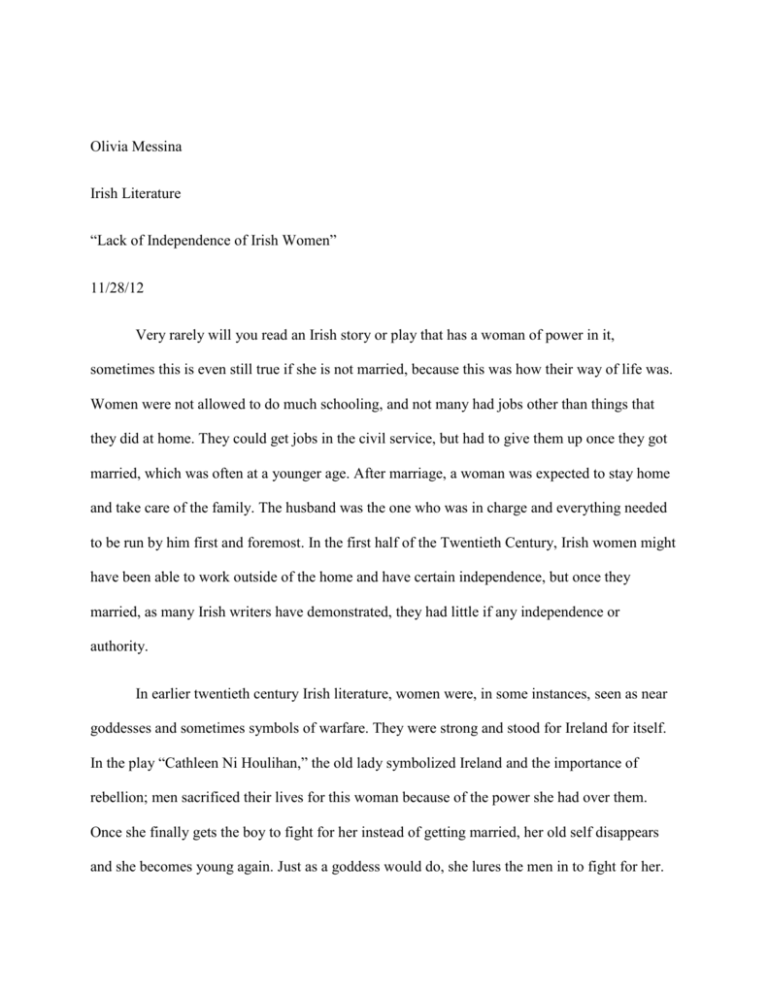Olivia Messina Irish Literature “Lack of Independence of Irish
advertisement

Olivia Messina Irish Literature “Lack of Independence of Irish Women” 11/28/12 Very rarely will you read an Irish story or play that has a woman of power in it, sometimes this is even still true if she is not married, because this was how their way of life was. Women were not allowed to do much schooling, and not many had jobs other than things that they did at home. They could get jobs in the civil service, but had to give them up once they got married, which was often at a younger age. After marriage, a woman was expected to stay home and take care of the family. The husband was the one who was in charge and everything needed to be run by him first and foremost. In the first half of the Twentieth Century, Irish women might have been able to work outside of the home and have certain independence, but once they married, as many Irish writers have demonstrated, they had little if any independence or authority. In earlier twentieth century Irish literature, women were, in some instances, seen as near goddesses and sometimes symbols of warfare. They were strong and stood for Ireland for itself. In the play “Cathleen Ni Houlihan,” the old lady symbolized Ireland and the importance of rebellion; men sacrificed their lives for this woman because of the power she had over them. Once she finally gets the boy to fight for her instead of getting married, her old self disappears and she becomes young again. Just as a goddess would do, she lures the men in to fight for her. Ireland was being symbolized as a mythical woman who was forceful in what she wanted, and that is not the case in later Irish literature. For a while in Irish history and literature, Cathleen Ni Houlihan appeared and was seen as a Queen to many. Then a shift in literature showed more of a male dominant role in life. Although women had some independence before getting married, it was not much more than after they had married. Younger women, before marriage, were limited with schooling. Single women would work in the civil service, most of the time as nurses; they could have other jobs such as teachers, foster mothers, or nannies preparing them to be a future wife or mother. A lot of the time, a single Irish woman would have to take care of other people’s children. It was assumed, most of the time that a single woman would leave her job eventually to get married and already know how to take care of a family. If they were the only woman left in the family and had not yet married they would have to obey their father. It did not matter how a man acted towards a woman, she was to be respectful, care for him, and be generous just like what was expected of Irish women. For example, Eveline in the story “Eveline,” by James Joyce is a perfect example of what a single Irish woman might do. Her mother, sister, and brother have died, and her last brother moved away and left her with their sick father, who is a potential threat. Eveline is faced with the decision of running off and getting married or staying and taking care of her father; she chooses the latter. Her decision was more uncommon than most. She works at whatever job she can and gives her father all of the money. She also has to beg him to give her any money for anything at all; “In the end he would give her the money and ask her had she any intention of buying Sunday’s dinner?” (Dubliners, “Eveline”, 21). This is normally how Irish households handled money; the man was in control of it. Her father not only gave her money reluctantly, but insisted that his meals be ready on time. A typical single Irish woman would have to maintain the house regardless of being single or married; it was her job. Since she didn’t have a family of her own it was expected that she would take care of other people’s children. Joyce makes it clear that Eveline did both things regularly, and on page 21 the narrator says, “She had hard work to keep the house together and to see that the two young children who had been left to her charge went to school regularly and got their meals regularly. It was hard work—a hard life.” Another single Irish woman’s role is depicted in the story “A Ballroom of Romance,” by William Trevor. Bridie, like Eveline, has a sick father, and her mother is dead. She takes care of the household. She looks rough because she is the one who has to perform all of the labor in order to provide the things that they need. Trevor describes the toll that the work has taken on Bridie when he says, “Wind had toughened the flesh of her face, sun had browned it; her neck and nose were lean, her lips touched with early wrinkles,” (Modern Irish Short Stories, 498). It was a hard life being a woman and having to take everything on alone without a choice. She wanted to get married, but family is highly valued in Irish culture, so the care of her father came before her own needs. In addition to Bridie following the characteristics of single Irish woman, Mrs. Griffin, who has a mentally ill child, takes in the man that she likes because he is alone; this is the type of thing that single Irish women were supposed to do as their duty. The story “Eveline” was published before Irish women’s rights became lessened; “A Ballroom of Romance” was after. Although single women had limited rights, married women were stuck with close to no rights. Irish women went from being seen as a strong figure of Ireland, to being mostly silenced in multiple ways and having their independence stripped little by little. In 1926 only about six percent of married women worked, and then The Juries Act of 1927 made it so that women couldn’t do jury service. Only men would be able to voice an opinion (“Irish Women in the Twentieth Century” Ch.1). The Employment Bill of 1935 allowed the government to limit employment of women in any industry, (“Irish Women in the Twentieth Century” Ch.1). Soon after, women were actually required to quit their jobs if they were to going to marry; there was no longer an option. This is why in most twentieth century Irish literature, the women are at home caring for the family. “For the sake of the nation, women’s role was to be confined to the home where she was to ensure the stability of the state, the preservation of the family and the upholding of Catholic values,” (“Irish Women in the Twentieth Century” Ch.1). The words woman and mother truthfully became interchangeable. No matter what circumstances, women were to stay with their husbands; divorce was not an option, happy or not. The men controlled everything in the marriage. A woman was not allowed to do anything on her own without permission. There are many examples of women taking a back seat to a husband’s word in Irish literature. In “The Twisting of the Rope,” by W. B. Yeats, a Bard named Hanrahan wants to come into the couple’s home. The wife knows that this is a bad idea and does not want him to come in, but her husband says, “I will never turn away Hanrahan of the poets from my door,” and that is the end of the discussion. The husband’s word is the one that matters in a marriage. When it comes to handling money, that is the man’s job. In “Araby,” by James Joyce, an aunt and uncle care for their nephew. He would like money to go to Araby, but only his aunt is home, and she couldn’t give him the money since she is a woman. The little boy has to wait until his uncle came home from the bar to ask for money; the husband gives out the money. The wife has to ask for permission: “Can you give him the money and let him go? You’ve kept him late enough as it is” (Dubliners, page 18). According to Irish Women in the Twentieth Century, No woman was allowed to take out a loan or even open a bank account if she didn’t have her husband’s signature on it. Even though a lot of the time in Irish stories the husband is not a good husband and is often times a drunk, women were not allowed to divorce under any circumstances. In the 1940s and 50s women were “confined to domestic roles, restricted in their professional lives and forbidden access to contraception, abortion and divorce” (Irish Women in the Twentieth Century Ch.1). “A Painful Case,” by James Joyce, shows the struggle of a woman in a bad marriage, but the woman knows she cannot get out. Mrs. Sinico’s husband is always away, and she has nothing in common with him. She starts to look for love with Duffy secretly because she knows she can’t leave her husband and child. Mr. Sinico “Dismissed his wife so sincerely from his gallery of pleasures that he did not suspect that anyone else would take an interest in her,” (Dubliners, 72). Unhappy with her life she turns to alcohol and ends up dying in an accident. In the story “Grace,” also by James Joyce, provided is another example of a bad marriage with no way out for the wife. Mr. Kernan is an alcoholic, but his wife knows she can’t do anything about it. He does what he wants with their family money, and even beats his children. The wife has little or no power over their money and cannot file for divorce. She is stuck in an unhealthy relationship and no way out. Irish women were expected to care for their families regardless of the situation. They were to nurture their children and tolerate their husbands. In “Juno and the Paycock,” by Sean O’Casey, Juno’s husband, Captain Boyle, is a drunk who refuses to hold a job. She has to work for him. Because her husband refuses to change his life, she must support everyone on her own. When her daughter gets pregnant out of marriage, Juno fights for her child although Captain Boyle cuts her off. What the husband says goes, so she is exiled, but Juno takes Mary and leaves. The same goes for the story “Happiness” by Mary Lavin. The wife’s husband died and she continued to try to support her family and give them a happy life. She is willing to sacrifice her comfort and time for the people in her family who need her most. “There were evenings after she came home from the library where she worked when we saw her stand with the car keys in her hand, trying to think which would be worse—to slog over there on foot, or take out the car again. And yet the distance was short. It was mother’s day that had been too long,” (Modern Irish Short Stories page 403). Although she had to work all day for her family, she knew she had other duties to fulfill and no one else, but her close friend the Priest to help her. Up until her last breathe she was worried about things left for her to do for the family. Women were taught to be the ones that cared for the family because that was their sole job as a wife; she had barely any outside help, but was expected to be able to care for all of the things that needed cared for. Irish men had priority over Irish women in many things. The man was supposed to be the breadwinner of the family and the wife wasn’t to challenge that. In the 1950’s children’s allowances were proposed and the money would go to the mother to care for the children; it was later turned down because it supposedly took over the father’s role of providing for the family. It was acceptable for a man to get an education and have a job, but women were actually looked down upon if they chose those things over finding a husband and having children. In the twentieth century, women’s role was to make men happy and a lot of Irish women at the time believed that that truly was the case. They would do everything from taking care of the kids to milking the cow or picking hay if they lived on a farm. The father would stick to the handyman things and there were very few, if any that dealt with the care for the children. Men did not want that job and felt that that was what women were here for. A man wouldn’t be held accountable for a lot of things that he did in a marriage, whereas if a woman did the same things, she would be. If a woman was unfaithful to her husband she wouldn’t get away with it, but if the situation were reversed, it would be overlooked. For example, in “Exile’s Return” by Bryan MacMahon, the father, Paddy leaves his wife and children for six years. He continues to send them money and his wife just lives with the situation. Paddy returns to Ireland only after he discovers that his wife had a child with another man. He was going to kill the wife for what she did, but the daughter softens him up. Even though Paddy had left his wife, she still had to apologize, saying “I broke my marriage-mornin’ promise, but I’ll make up for it” (Modern Irish Short Stories page 393). In “Made in Heaven,” by Maura Treacy, the husband, Tim, expects his wife, Rose, to cook, clean, and take care of him like a good Irish wife should do, and when she doesn’t do that he hits her. He thinks that hitting her is going to shape her up. Although she stands up for herself, he would more than likely never get in trouble for hitting her. She wasn’t doing what she was expected to do. Lastly, in “The Day of the Christening” by Hamet O’Carroll a girl names Rosaleen is raped and becomes pregnant. Now, today that would not be taken lightly, but then it was seen as her fault. Her own father didn’t even take action for what happened to his child, saying, “You’re fine bucko, Connors has raped our Rosaleen. She is expecting his kid” (Territories of the Voice page 56). Everyone talked about the girl behind her back. All that Rosaleen’s mother could do was listen to her husband’s criticism because he was the man of the house. Like Corley in “Two Gallants” men seduced and played women like instruments, but nothing bad would happen to them in the end. Although the women were being treated unfairly, they had no control over the situation; men had more authority. Women’s sexuality was also monitored. Women had to wear stockings underneath their dresses and if they weren’t, they were considered sinful. “Single mothers and other women who were seen to flaunt their sexuality were ostracized for their supposedly ‘deviant’ behavior” (“A Feminism of their own” by Mary Ryan, 93). Women were held to a higher moral standard than men where. Elizabeth Bowen shows how Emma in “Summer Night” is regarded when she is not wearing stockings. Her behavior is viewed as scandalous. She was not behaving as a housewife should. The lack of power women had in the first half of the twentieth century is evident in Irish short stories from the time. Married women were kept on an even tighter leash than single Irish women. Their life choices were narrow before marriage and almost non-existent after marriage. Woman and mother really were interchangeable and women mainly succumbed to men’s wishes. The government and Irish men made it so that women were really left with no room to be their own person. Bibliography: 1. DeSalvo, Louise A., Kathleen Walsh. D'Arcy, and Katherine Hogan. Territories of the Voice: Contemporary Stories by Irish Women Writers. Boston: Beacon, 1989. Print. 2. Ford, Patrick K. "Chapter 8." Ulysses. By J. E. Caerwyn Williams. N.p.: University of California, n.d. N. pag. The Irish Ulysses. Univsersity of California Press. Web. 20 Nov. 2012. 3. Forkner, Ben. Modern Irish Short Stories. Harmondsworth, Eng.: Penguin, 1980. Print. 4. Holden, Katherine. "Management and Organizational History." Other People’s Children: Single Women and Residential Childcare in Mid-20th Century England (2010): 314-26. Sagepub.com. SAGE, 27 Aug. 2010. Web. 20 Nov. 2012. <http://moh.sagepub.com/content/5/3-4/314.full.pdf html>. 5. Ingman, Heather. "Chapter 1." Irish Women in the Twentieth Century. Burlington: Ashgate Limited, 2007. 1-27. Print. 6. Innes, C. L. "The Review of English Studies." Women and Nation in Irish Literature and Society (1996): 283-84. Www.jstor.org. Oxford University Press. Web. 20 Nov. 2012. 7. Joyce, James. Dubliners,. New York: Modern Library, 1926. Print. 8. Ryan, Mary. "A Feminism of Their Own?: Irish Women’s History and Contemporary Irish Women’s Writing." (2010): 92-101. Www.estudiosirlandeses.org. 27 Jan. 2010. Web. 20 Nov. 2012.






